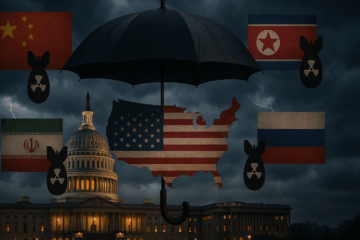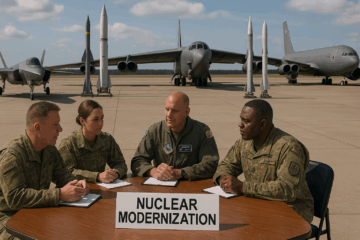On the surface, the subject matters of drones and nuclear deterrence seem far apart. Drones and other autonomous vehicle technologies already influence the conduct of war in a significant way. So far, drones’ impact is discussed in the context of conventional war. They may also have potential impact on nuclear deterrence, altering nuclear strategy by undermining stable deterrence. This possibility has implications for future decisions concerning American nuclear modernization and for setting priorities in future arms control negotiations.
Their low cost, flexibility, and ability to operate without putting human pilots at risk make drones increasingly valuable in conventional military conflicts. Their capabilities already include reconnaissance and surveillance, long-range strike missions, electronic warfare, and precision killing.
With their precision-targeting ability, drones can be integrated into nuclear deterrence strategies. For instance, they could be used to ensure the survivability of a country’s nuclear forces by providing continuous surveillance and early warning against potential nuclear threats. Drones could also support a more viable second-strike capability, potentially increasing the credibility of nuclear deterrence by ensuring that a country retains a means to retaliate even after a nuclear first strike.
The use of drones in situations where nuclear escalation is a possibility could lead to unintended consequences. The increasing autonomy of drones raises the risk of misinterpretation, as drones could be perceived as a precursor to a larger attack, even when they are only conducting reconnaissance. This could trigger a preemptive nuclear strike by an adversary, leading to an inadvertent escalation into full-scale nuclear war. Cold War and subsequent histories show that the danger of inadvertent nuclear escalation is not trivial.
The possibility that expansion of the war in Ukraine from conventional weapons into nuclear first use could occur from Russian views of Ukrainian deep strikes into Russian territory, with NATO ballistic and cruise missiles, provides one example of concerns in this category. Lewis A. Dunn suggests that President Donald Trump is faced with a world sliding into nuclear anarchy. He writes:
Brinkmanship among major nuclear powers is rising. China is relentlessly expanding its nuclear forces but rejecting serious engagement with the United States on arms control. US–Russia cooperation on nuclear matters, already in a dire state, has deteriorated further with President Vladimir Putin’s repeated nuclear threats in the course of Russia’s war in Ukraine. Recent reports based on information from senior US officials indicate that the United States, too, could modify its posture and expand its arsenal to strengthen deterrence of coordinated Russian, Chinese, and North Korean nuclear adventurism. All these developments have eroded critical pillars of nuclear order and raised the risk of nuclear warfare.
Drones are relatively fast, low-cost, and difficult to detect, which makes them ideal for preemptive strikes against high-value targets. In theory, a nation could deploy a drone strike against an adversary’s nuclear command-and-control infrastructure or missile silos, aiming to disrupt or neutralize a potential nuclear retaliation before it can be launched. In addition, drones equipped with nuclear payloads or advanced conventional weapons could be used as part of a disarming strike. The ability to carry out such strikes could shift the strategic calculations of nations, as adversaries might feel more vulnerable to a preemptive attack, especially if they believe their nuclear retaliation capabilities could be neutralized by fast-moving drone strikes.
As drones become more autonomous, the risk of them making decisions without human oversight increases. In a nuclear context, where the consequences of any action are catastrophic, the delegation of decision-making to machines is highly controversial. The potential for autonomous drones to trigger a nuclear response or make fatal miscalculations due to algorithmic errors presents a possible threat to strategic stability.
Given that drones can operate autonomously, one challenge is ensuring that their actions do not trigger unintended escalation. Moreover, the reliance on technological systems for communication and control in a nuclear context raises concerns about vulnerabilities in these systems, especially if adversaries employ cyberattacks or electronic warfare tactics to disrupt drone operations.
Future generations of drones will interact with artificial intelligence that also supports other elements in the matrix of deterrence and defense. AI will privilege deterrence by denial compared to deterrence by credible threat of unacceptable retaliation. It will do so because states will have to quickly manage the deterrence and/or conduct conflicts in multiple domains: land, sea, air, space, cyberspace, and the information or knowledge domain. The knowledge domain wraps around all the others. It is the “gnostic center” that controls, connects, and prioritizes among the component parts of the various domains in order to provide for the correct response to threats or attacks.
AI-assisted attacks on the gnostic center will require immediate responses by AI-assisted defenses that can defeat or diminish the cost of those attacks. Absorbing the first blow and then retaliating may not be a choice that is available to beleaguered and time-pressed decision-makers. This situation poses an especially concerning challenge for nuclear deterrence. Decisions for or against nuclear war should allow policymakers sufficient time to deliberate alternatives with their advisors and to select the most appropriate option for the exigent circumstances. But the potential speed of AI-boosted attacks against space and cyber assets, together with the rising speed of kinetic strikes from hypersonic weapons, may leave leaders fearful of an enemy nuclear first strike to choose preemption instead of retaliation.
Just as we can conceive of drones as reconnaissance and strike platforms for offenses, it is also possible that drones can be part of any state’s comprehensive antimissile and air defense plan. One illustration is the use of drone swarms to defeat attacking drones tasked with reconnaissance or strike missions. Another example would be the use of drones for electromagnetic “hit to kill” within the atmosphere or, even more ambitiously, in midcourse intercept against attacking ballistic missile forces. Drones based on one or more lunar spaceports could protect American interests in cislunar space.
Futuristic drones with embedded AI and space-to-space weapons could defend orbital satellites against attack (so-called DSATs) or engage another state’s satellites that appear threatening (ASATs). Priority DSATs and ASATs would deter or defend against any threat to the viability of American satellites for warning and assessment; command, control, and communications; geolocation; and other missions.
Comparatively inexpensive drones could thus take over some of the strategic defense burden, otherwise requiring both upgraded terrestrial missile launchers and kill vehicles or, eventually, sophisticated ballistic missile defenses based on space-to-earth weapons such as lasers or particle beams. Future planners should expect a more crowded space domain, including newer generations of orbital satellites with diverse missions, space stations, and additional reconnaissance and strike weapons along with smarter drones and larger swarms.
The preceding discussion about drones and their possible relationship to nuclear deterrence has implications for nuclear arms control. It is important for a peace agreement to terminate the war in Ukraine for many reasons. One reason is so that the United States and Russia can resume negotiations about an arms control regime to succeed the New START agreement, due to expire in 2026.
The “beyond New START” consultations should include discussions about the two states’ arsenals of non-strategic nuclear weapons and protocols for nuclear first use. Vladimir Putin’s repeated warnings about the possibility of Russian nuclear first use in Ukraine is dismissed by some as bluffing for effect, a form of coercive diplomacy. On the other hand, Russia’s doctrinal shifts appear to move toward a more permissive standard as the war continues. In addition to clarifying this matter, the United States and Russia must acknowledge that China is an aspiring nuclear peer and include China in discussions about nuclear policy issues, including transparency about force structures and military doctrines. China is unlikely to be interested in arms reductions per se, but dialogue should be initiated at the expert level to clarify China’s thinking about strategy, arms control, and related issues.
The character of war changes with the advent of new technologies and strategic thinking. But the nature of war is perennially the environment of competition and conflict, uncertainty, chance, and friction. The relationship between drones and nuclear deterrence represents a mixed blessing for military planners and arms control. Drones have the potential to enhance nuclear deterrence, but they also introduce significant risks in terms of escalation control and first-strike stability. As drone technology advances, it will be critical for policymakers to develop strategies that account for the unique challenges drones pose in nuclear deterrence and, as well, their future roles in space and cyber wars.
Professor Stephen Cimbala, PhD, is a Senior Fellow at the National Institute for Deterrence Studies.
About the Author

Stephen Cimbala
Dr. Stephen Cimbala is Distinguished Professor of Political Science at Penn State university, Brandywine. He is currently a senior fellow with the National Institute for Deterrence Studies.





Thanks to Prof. Dr. Stephen Cimbala for a breakthrough article at several levels. Note, in particular, this segment: “Future generations of drones will interact with artificial intelligence that also supports other elements in the matrix of deterrence and defense. AI will privilege deterrence by denial compared to deterrence by credible threat of unacceptable retaliation.” This, and subsequent paragraphs, provide a segway to the rapidly changing evolution of strategy and conflict. Even if first principles remain unchanged, technology, and access to it from a variety of actors, reshuffle the game like never before. We’re up for strategic surprises and rude wake up calls unless we adapt and anticipate. This is valid in all domains, especially space.